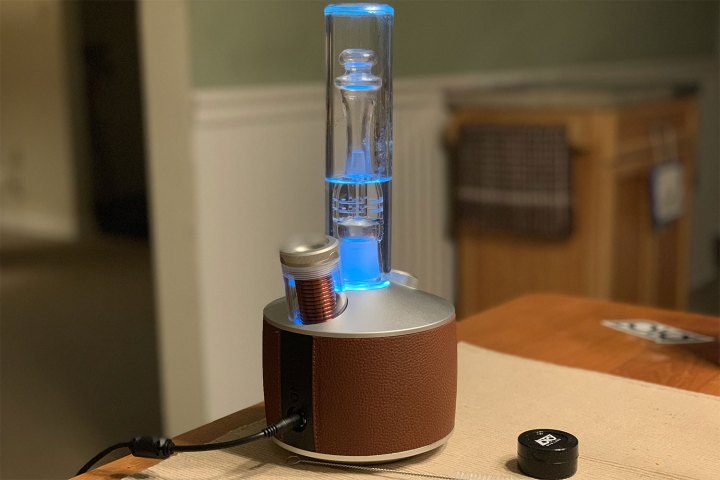
With cannabis vaporization becoming an ever more popular method of consumption, the number of devices on the market seems to be increasing exponentially. With this increase, there’s also a larger number of no-name devices from companies we’ve never heard of – many of which pitch Digital Trends in an effort to get some exposure. The vast majority of these make cut-rate products, but others leave us pleasantly surprised.
Loto Labs is one of the latter, born out of a successful Indiegogo funding campaign. Truth be told, when the company pitched us on its first commercially available device, dubbed the Legend, we scoffed a bit at the $500 price tag. This is the most expensive cannabis consumption device we’d ever considered testing. Could it really live up to it’s exorbitant asking price? Could it outperform the our favorite induction heat vaporizer of all time, the Dr. Dabber Switch? Could Loto Labs hit a home run on its first try?
We were excited to find out.
Design
Much like Dr. Dabber’s Switch, performance is put before portability with the Legend. While smaller than the Switch overall, it’s definitely still a desktop device. You’ll also need to plug the device in to a wall outlet to use it. The Legend has no internal battery, so it isn’t going to be a rig you’ll take with you unless you’ll have an power outlet nearby.
We are extremely impressed with the construction quality all around.
This is not to say that the Legend isn’t aesthetically pleasing. Its round stainless steel and anodized aluminum base is covered in microfiber that feels (and looks) like the surface of a football. In addition to looking pretty snazzy, this also allows you to grip the device more securely. A cylindrical hand-blown glass bubbler sits on top of the device, and a rotatable knob on the base itself allows you to literally dial in the perfect temperature.
Finally, the heating element – just like the Switch – features induction coils which, when a small piece of aluminum (called a “susceptor”) is inserted, heat up and vaporize your concentrate.

We are extremely impressed with the construction quality all around. Loto Labs didn’t cheap out on any materials, which helps justify the high price tag. While it does take quite a bit of assembly out of the box (not helped by vague and sometimes incorrect directions), once the device is assembled, it’s really as easy as pressing down on the dial to start it, picking a heat setting, and dropping your material into the chamber.
Be ready to go, though. The Legend heats up in as little as five seconds, which is the fastest we’ve seen on an electric rig. Based on our tests, it also produces massive amounts of vapor – arguably even more than the Switch. Regardless of this quick and efficient heat-up process, the base, never got very hot to the touch at any point.
Performance
In our Switch review, we complemented Dr. Dabber on how well it performed. Loto Labs has them beat. The Legend works with all kinds of material, whether it be sugar, budder, sauce, or shatter — with absolutely no problem. Every time, we were getting consistently thick and voluminous clouds, and the concentrate was completely vaporized save for the residue you’d expect.
The Legend works with all kinds of material with absolutely no problem.
The Legend is the best example of cannabis induction vaping that we’ve seen thus far. Perhaps this is because Loto Labs decided to make the Legend a plug-in unit (which would provide a consistent level of power to the coils) in lieu of a battery-powered model. We’re not sure, but however they’re doing it, it most certainly is working.
The device itself stays heated for about ten seconds after reaching its temperature. Even after the device shuts off, the susceptor is hot enough for a few seconds afterwards to continue to vaporize, so keep puffing. While the Legend lacks the customization features of other devices, it’s not that big of a deal. You can precisely dial in your desired dabbing temperature, and it’s easy to do. No need to overcomplicate things.

That said, the Legend does come with built-in Bluetooth connectivity, which not only allows you to update your rig’s firmware, but also to more precisely dial in operating temperature. The app itself is well designed, but it’s more of just an added convenience feature – we don’t really see it as a vital part of operation like it would be for portable vapes like the Pax 3 or DaVinci IQ.
If there’s one thing we’d gripe about, it’s the setup instructions. While Loto Labs does do a good job of showing you pictures on how the various parts need to be attached together, we found it a little hard to follow at times. Really though, that’s the only downside of this device.
Verdict
The Legend arguably sets the standard for performance for any induction-based vaporizer after it. If concentrates as your primary method of cannabis consumption, and you can part with $500 – it might be time to put the torch and heady glass away.
So should you buy it? depends. If you’re not a big concentrate user, stepping down to the Switch ($100 less) might be a better choice as it also supports dry leaf as well out of the box. If you’re only a casual cannabis consumer, then we’d suggest investing in a portable device itself. But for purely dabs this is the rig to have.
We’re just blown away by the performance and build quality. Everything about this device just feels upscale (despite those directions).


